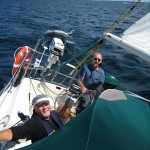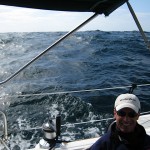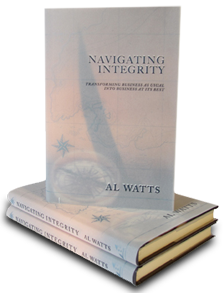Recently a colleague shared her distress with the turmoil, continuous change and what seemed like unrealistic expectations at her workplace. As she described the conditions and her reactions, I couldn’t help thinking how similar they were to those of mates I’ve sailed with who suffered from seasickness. The more I thought about it, not only were the symptoms of what she described like seasickness, but some remedies apply to both as well:
We’re better off above than below-deck. I’m not just talking about higher in the hierarchy here; although conditions up the organization chart may be better in some ways than in “steerage,” that poses its own set of problems. The worst place to be when seasick is below-deck. It’s close-quarters, the air isn’t as fresh, one can get banged around and it’s hard to stay balanced. It’s amazing what simply “getting above it all” for a period can do to restore spirits and reset our “gyroscope.” Every once in a while at work too we need to get above it all to gain some perspective and regain our balance. That might mean taking a break (outdoors preferably,) taking deep breaths and trying to connect with the bigger picture. In his book Leadership Without Easy Answers, Ronald Heifitz used a similar analogy about how leaders can gain better perspective by viewing the “dance” from a “balcony” above.
is below-deck. It’s close-quarters, the air isn’t as fresh, one can get banged around and it’s hard to stay balanced. It’s amazing what simply “getting above it all” for a period can do to restore spirits and reset our “gyroscope.” Every once in a while at work too we need to get above it all to gain some perspective and regain our balance. That might mean taking a break (outdoors preferably,) taking deep breaths and trying to connect with the bigger picture. In his book Leadership Without Easy Answers, Ronald Heifitz used a similar analogy about how leaders can gain better perspective by viewing the “dance” from a “balcony” above.
Focus on the horizon. When sailing in rough conditions, focusing on the horizon or distant shore is immensely helpful countering seasickness. The horizon provides a more peaceful looking focal point, distraction from much of the immediate commotion, and a steadier platform for stomachs. It’s also much easier steering to a distant point or by a star in rough seas than by any wildly swinging compass needle. When things get rough at work, it’s also important to focus on the horizon – our vision or big picture. We can “check our bearings,” remind ourselves of our larger purpose and why we’re doing what we’re doing. Perhaps we need to look up from some of the details to refocus on larger goals.
Do something! There is usually much to do when sailing in rough weather – if nothing else, keeping one’s balance and staying in the boat! Seasickness is often not as likely with  wild waves as with swells in calmer weather – high, gentle rollers that rhythmically raise and lower the boat all day. Many times then it’s helpful just finding something to do – trimming sails, coiling loose lines, stowing gear or practicing knots. Doing something, anything, at least shifts our attention away from getting sick (aboard or at work.) For me, I know that when there’s a long list of “to-dos” getting me down at work – especially if not my favorite activities, just starting on one can get me back in the game.
wild waves as with swells in calmer weather – high, gentle rollers that rhythmically raise and lower the boat all day. Many times then it’s helpful just finding something to do – trimming sails, coiling loose lines, stowing gear or practicing knots. Doing something, anything, at least shifts our attention away from getting sick (aboard or at work.) For me, I know that when there’s a long list of “to-dos” getting me down at work – especially if not my favorite activities, just starting on one can get me back in the game.
Take care of yourself. The best preventer of seasickness is taking care of one’s self. That means resting, eating, hydrating and staying fit as best one can; for some it also means taking medication (for actual seasickness, Bonine works well.) That goes for “motion sickness” at work too; when body, mind or spirit is off, one usually affects the others as well as the journey. (And remember, “hydrating” means water!)
Rely on crew mates. It’s important for crew members to take care of themselves as well as each other, and to accept help when it’s offered; as Ralph Waldo Emerson said: “No crew members should be praised for the rugged individuality of their rowing.” Aboard or at work, check in with each other from time to time. Offer advice or assistance, or just give someone space who needs it. Remember that our own and others’ reactions will be different when fearful or stressed, and compensate accordingly.
Know when its time to change course or haul anchor. As the saying goes: “If we keep doing what we’re doing, we’ll keep getting what we’re getting.” Actually, at sea or at work, if we doggedly hold an untenable course, things will likely get worse; we might capsize or end up on the rocks. We need to know our own limits, the limits of our vessel (organization) and the limits of our crew. A change in course, sail trim, anchorage or even destination can make for a much happier crew and far better outcomes.
Remember, it’s temporary. Rough weather subsides, we can alter course, change our destination, or even return to port. Sometimes, conditions don’t get better but we do by riding them out. It takes a while for new crew to get “sea legs.” On one cruise off Central America, one crew member had a rough time of it for two or three days, displaying various shades of green. Some of the above helped, but mainly it just took him and his “internal gyroscope” time adjusting to the new realty at sea; after crossing that threshold he was the best crew mate one could hope for.
 When do you feel “motion sick” at work? Can you try some of these tactics?
When do you feel “motion sick” at work? Can you try some of these tactics?
- Get “above deck” or on the “balcony.”
- Focus on the “horizon.”
- Do something – anything!
- Take care of yourself.
- Ask for help and respond to it.
- Change course or haul anchor.
What else do you recommend for those feeling “seasick” at work?
“No one would have crossed the ocean if able to get off the ship in a storm.”
Charles F. Kettering
“A ship in harbor is safe, but that is not what ships are built for.”
William Shedd







Thanks for the insightful analogy Al, and for the emphasis on awareness, choice, focus, collaboration, mindset & attitude.